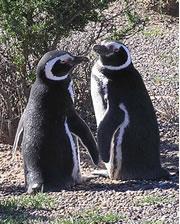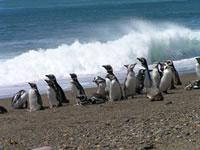 Will these penguins one day be deprived of anchovy snacks?E. Skewgar
Will these penguins one day be deprived of anchovy snacks?E. SkewgarThe Magellanic penguins of Punta Tombo don't tap dance like the cartoon birds from the movie Happy Feet, but they do sing. Each summer, hundreds of thousands of the birds converge on a bit of Patagonian coastline to breed among the desert shrubs. It's the world's largest colony of Magellanic penguins, and all together they raise quite a ruckus.
"They're brayers," says Elizabeth Skewgar, an ecologist who has studied the birds. "The word 'cacophony' comes to mind."
Skewgar, a graduate student at the University of Washington in Seattle, is worried that a nearby experimental anchovy fishery, approved in 2003, might one day quiet the party at Punta Tombo.
Oily anchovies provide a high-energy meal for penguins, sea lions, dolphins and cormorants, to name but a few. The pivotal role these tiny fish play in the food chain means that depleting their stocks could cause an ecological conundrum that the Magellanic penguins won't be able to dance their way out of.
That crisis point hasn't yet been reached, but in an article in this week's Science1, Skewgar and her colleagues argue that it's important to plan ahead before economic pressures make it impossible to reign in anchovy catches.
The anchovy fishery, located in the Province of Chubut, is relatively small-scale now, with about 30,000 tonnes of southwest Atlantic anchovy (Engraulis anchoita) caught in Argentina annually in 2004 and 2005. But this is expected to grow in light of rising worldwide demand. Demand is swelling rapidly, in part because fish farms rely on meal made from tiny fish such as anchovies to feed their stock.
A conservative management system needs to be put in place now, argues Skewgar. The limits in place today are appropriate, she says, but firmer plans should be made for the future.
Runaway fishing
 Adult and juvenile Magellanic penguins resting andpreening their feathers on the beach.E. Skewgar
Adult and juvenile Magellanic penguins resting andpreening their feathers on the beach.E. SkewgarTony Pitcher, founder of the University of British Columbia's Fisheries Centre in Vancouver, Canada, agrees that there is cause for concern, citing a history of mismanagement of Argentine fisheries. Twenty years ago, Argentine fishers relied heavily on a plentiful supply of hake (Merluccius hubbsi), a fish similar to cod that was widely exported. "There were whole 747s of hake going to Europe at one point," says Pitcher.
By the late 1990s, there were signs that the hake supply was dwindling, prompting the government to announce that hake fishing was in a state of emergency in 1999. As the supply of hake shrivelled, government regulators struggled to cut back fishing.
"Once problems began to appear, it was very hard for the government to reduce catch limits. And when the stock did crash, a lot of people's livelihoods were destroyed," says Skewgar. Since the crash, the government has banned hake fishing in large swaths of prized fishing areas, exacerbating the social crisis. Regional disputes mean that federal attempts to implement a new quota system have failed.
Safety first
Skewgar anticipates similar problems with anchovies unless steps are taken now.
A similar decline in anchovy stocks would not only hurt fisherman but also the penguins, she notes — not to mention the tourism industry in the Province of Chubut, which is worth hundreds of millions of US dollars a year.
Tim Essington, a fish ecologist at the University of Washington in Seattle, says it's good that Skewgar and her colleagues are raising a warning flag now, before the penguins begin to starve.
ADVERTISEMENT
A precautionary approach on setting fishing limits — one that would allow a safety margin for unanticipated events — is particularly important for small schooling fish such as anchovies, Essington adds. Populations of these fish live a 'boom and bust' lifestyle, multiplying rapidly in good times and suddenly withering away during periods of hardship. Combine a dose of environmental strife, such as a change in ocean temperature, with overfishing and the stocks could crash without warning.
Essington says that Argentine anchovy fishers would do well to follow the example set by the Commission for the Conservation of Antarctic Marine Living Resources, an organization of fishers and scientists who recommend catch limits for krill in the Southern Ocean. The Commission officially recognizes the uncertainty inherent in population modelling and has adopted a precautionary stance for krill catch limits.
Visit our anchovyfishery_cou.html">newsblog to read and post comments about this story.
